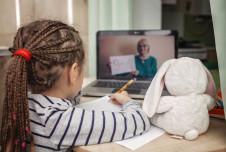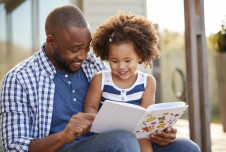At the peak of the COVID-19 pandemic, UNESCO estimates that 91.3% of the world’s students were learning remotely, with 194 governments ordering country-wide closures of their schools and more than 1.3 billion students learning in online classrooms.

Now that the building blocks of remote education have been put into place and classroom learning is underway, more and more teachers are turning their attention to the mental health of their students. Youth anxiety about the coronavirus is rising, and our young people are feeling isolated, disconnected, and confused. While social-emotional education has typically taken place in the bricks and mortar of schools, we must now adapt these curriculums for an online setting.
I have created six well-being activities for teachers to deliver online using the research-based SEARCH framework, which stands for Strengths, Emotional management, Attention and awareness, Relationships, Coping, and Habits and goals. Research suggests that students who cultivate these skills have stronger coping capacity, are more adaptable and receptive to change, and are more satisfied with their lives.
The virtual activities can be used for specific well-being lessons or advisory classes, or can be woven into other curricula you are teaching, such as English, Art, Humanities, and Physical Education. You might consider using the activities in three ways:
- Positive primer: to energize your students at the start of class to kickstart learning, prompt them to think about their well-being in that moment, get them socially connected online, and get their brain focused for learning.
- Positive pause: to re-energize students at a time when you see class dynamics shifting, energy levels dropping, or students being distracted away from the screen.
- Positive post-script: to reward students and finish off the class in a positive way before they log off.
Rather than viewing these activities as another thing you have to fit in, use them as a learning tool that helps your students stay focused, connected, and energized.
1. Strengths
Activity: Staying Strong During COVID-19
Learning goal: To help students learn about their own strengths
Time: 50 minutes
Age: 10+
Prior to the lesson, have students complete the VIA strengths questionnaire to identify their strengths.
Step 1: In the virtual class, explain the VIA strengths framework to students. The VIA framework is a research-based model that outlines 24 universal character strengths (such as kindness, courage, humor, love of learning, and perseverance) that are reflected in a student’s pattern of thoughts, feelings, and actions. You can learn more about the framework and find a description of each character strength from the VIA Institute on Character.
Step 2: Place students in groups of four into chat rooms on your online learning platform and ask them to discuss these reflection questions:
- What are your top five strengths?
- How can you use your strengths to stay engaged during remote learning?
- How can you use your strengths during home lockdown or family quarantine?
- How do you use your strengths to help your friends during COVID-19?
Step 3: As a whole class, discuss the range of different strengths that can be used to help during COVID times.
Research shows that using a strength-based approach at school can improve student engagement and grades, as well as create more positive social dynamics among students. Strengths also help people to overcome adversity.
2. Emotional management
Activity: Managing Emotions During the Coronavirus Pandemic
Learning goal: To normalize negative emotions and to generate ways to promote more positive emotions
Time: 50 minutes
Age: 8+
Step 1: Show students an “emotion wheel” and lead a discussion with them about the emotions they might be feeling as a result of the coronavirus pandemic. You can use this wheel for elementary school and this wheel for high school.
Step 2: Create an anonymous online poll (with a service like SurveyMonkey) listing the following 10 emotions: stressed, curious, frustrated, happy, angry, playful, sad, calm, helpless, hopeful.
Step 3: In the survey, ask students to enter the five emotions they are feeling most frequently.
Step 4: Tally the results and show them on your screen for each of the 10 emotions. Discuss the survey results. What emotions are students most often feeling? Talk about the range of emotions experienced. For example, some people will feel sad when others might feel curious; students can feel frustrated but hopeful at the same time.
Step 5: Select the top two positive emotions and the top two negative emotions from the survey. Put students into groups of four in virtual breakout rooms to brainstorm three things they can do to cope with their negative emotions, and three action steps they can take to have more positive emotions.
Research shows that emotional management activities help to boost self-esteem and reduce distress in students. Additionally, students with higher emotional intelligence also have higher academic performance.
3. Attention and awareness
Activity: Finding Calm During Coronavirus Times
Learning goal: To use a mindful breathing practice to calm our heart and clear our mind
Time: 10 minutes
Age: All
Step 1: Have students rate their levels of stress on a scale of 1-10, with 1 being very calm and 10 being highly stressed.
Step 2: Do three minutes of square breathing, which goes like this:
- Image a square in front of you at chest height.
- Point your index finger away from you and use it to trace the four sides of the imaginary square.
- As you trace the first side of the square, breathe in for four seconds.
- As you trace the next side of the square, breathe out for four seconds.
- Continue this process to complete the next two sides of the square.
- Repeat the drawing of the square four times.
Step 3: Have students rate their levels of stress on a scale of 1-10, with 1 being very calm and 10 being highly stressed. Discuss if this short breathing activity made a difference to their stress.
Step 4: Debrief on how sometimes we can’t control the big events in life, but we can use small strategies like square breathing to calm us down.
Students who have learned mindfulness skills at school report that it helps to reduce their stress and anxiety.
4. Relationships
Activity: Color conversations
Purpose: To get to know each other; to deepen class relationships during remote learning
Time: 20 minutes
Age: 10+
Step 1: Randomly assign students to one of the following four colors: red, orange, yellow, and purple.
Step 2: Put students into a chat room based on their color group and provide the following instructions to each group:
- Red group: Share a happy memory.
- Orange group: Share something new that you have learned recently.
- Yellow group: Share something unique about you.
- Purple group: Share what your favorite food is and why.
Step 3: Come back to the main screen and ask three students to share something new they learned about a fellow student as a result of this fun activity.
This is an exercise you can use repeatedly, as long as you ensure that students get mixed up into different groups each time. You can also create new prompts to go with the colors (for example, dream holiday destination, favorite ice cream flavor, best compliment you ever received).
By building up student connections, you are supporting their well-being, as research suggests that a student’s sense of belonging impacts both their grades and their self-esteem.
5. Coping
Activity: Real-Time Resilience During Coronavirus Times
Learning goal: To identify opportunities for resilience and promote positive action
Time: 30 minutes
Age: 10+
Step 1: Have students brainstorm a list of all the changes that have occurred as a result of the coronavirus. As the students are brainstorming, type up their list of responses on your screen.
Step 2: Go through each thing that has changed, and have the students decide if it is something that is within their control (like their study habits at home) or something they cannot control (like not attending school on campus).
Step 3: Choose two things that the students have identified as within their control, and ask students to brainstorm a list of ways to cope with those changes.
You can repeat this exercise multiple times to go through the other points on the list that are within the students’ control.
Developing coping skills during childhood and adolescence has been show to boost students’ hope and stress management skills—both of which are needed at this time.
6. Habits and goals
Activity: Hope Hearts for the Coronavirus Pandemic
Learning goal: To help students see the role that hope plays in setting goals during hard times
Time: 50 minutes
Age: 10+
Step 1: Find a heart image for students to use (with a program like Canva).
Step 2: Set up an online whiteboard to post the hearts on (with a program like Miro).
Step 3: Ask students to reflect on what hope means to them.
Step 4: Ask students to write statements on their hearts about what they hope for the world during coronavirus times, and then stick these on the whiteboard. Discuss common themes with the class. Finally, discuss one small action each student can take to create hope for others during this distressing time.
Step 5: Ask students to write statements on their hearts about what they hope for themselves, and then stick these on the whiteboard. Discuss common themes with the class. Finally, discuss one small action each student can take to work toward the goal they’re hoping for.
Helping students to set goals and have hope at this time can support their well-being. Research suggests that goals help to combat student boredom and anxiety, while having hope builds self-worth and life satisfaction.
The six activities above have been designed to help you stay connected with your students during this time of uncertainty—connected beyond the academic content that you are teaching. The intense change we are all facing has triggered heightened levels of stress and anxiety for students and teachers alike. Weaving well-being into online classrooms gives us the opportunity to provide a place of calm and show students they can use adversity to build up their emotional toolkit. In this way, you are giving them a skill set that has the potential to endure beyond the pandemic and lessons that may stay with them for many years to come.










Comments